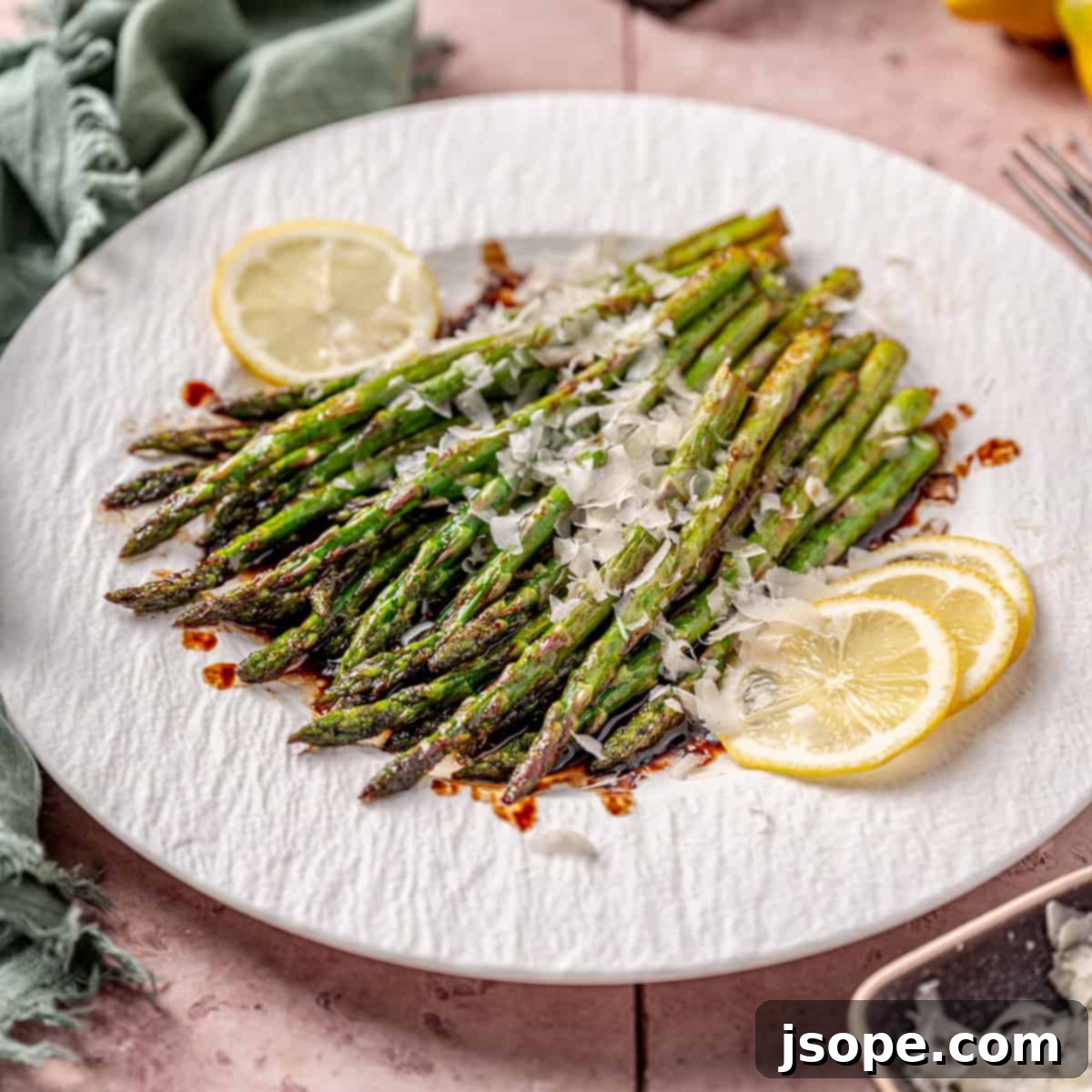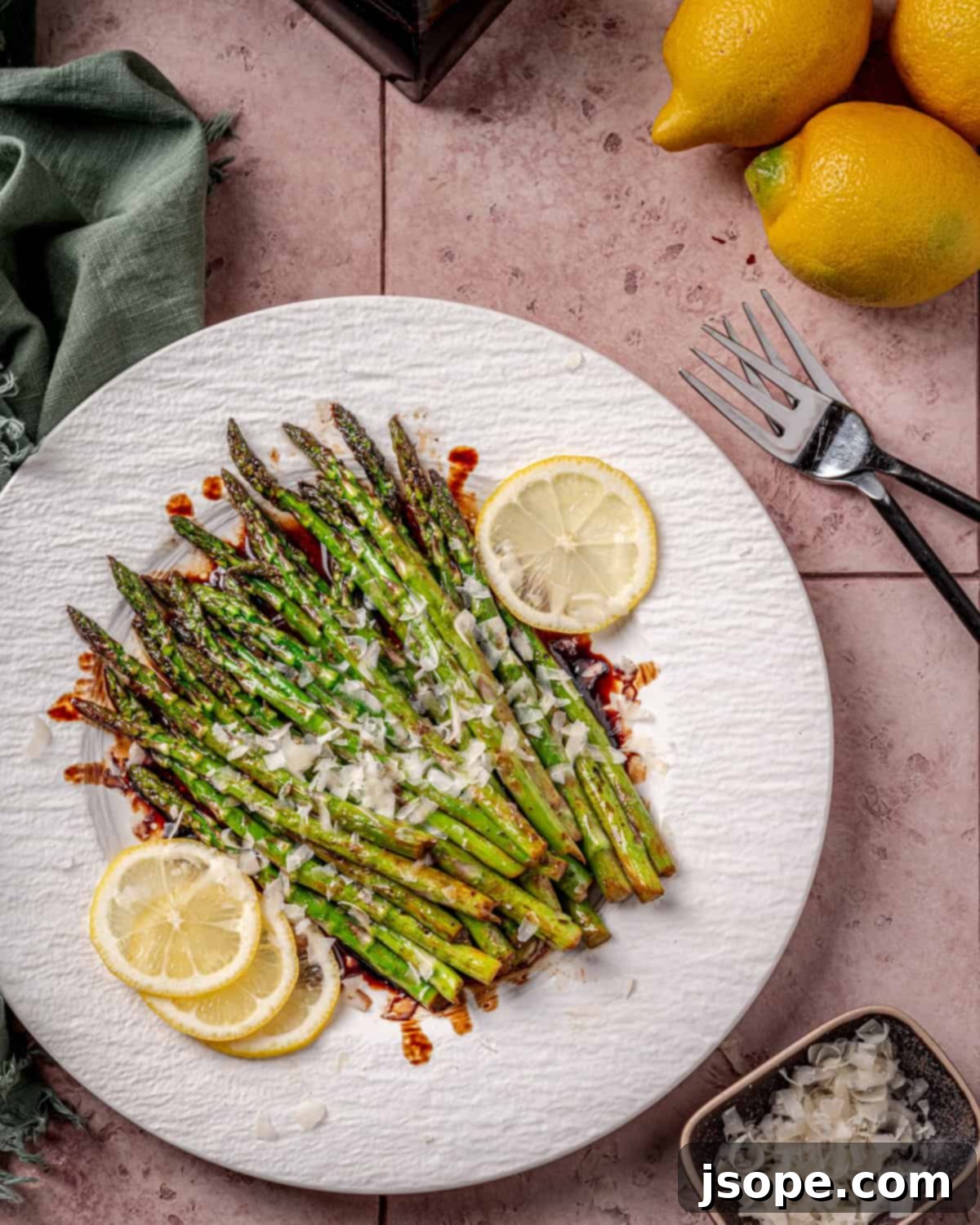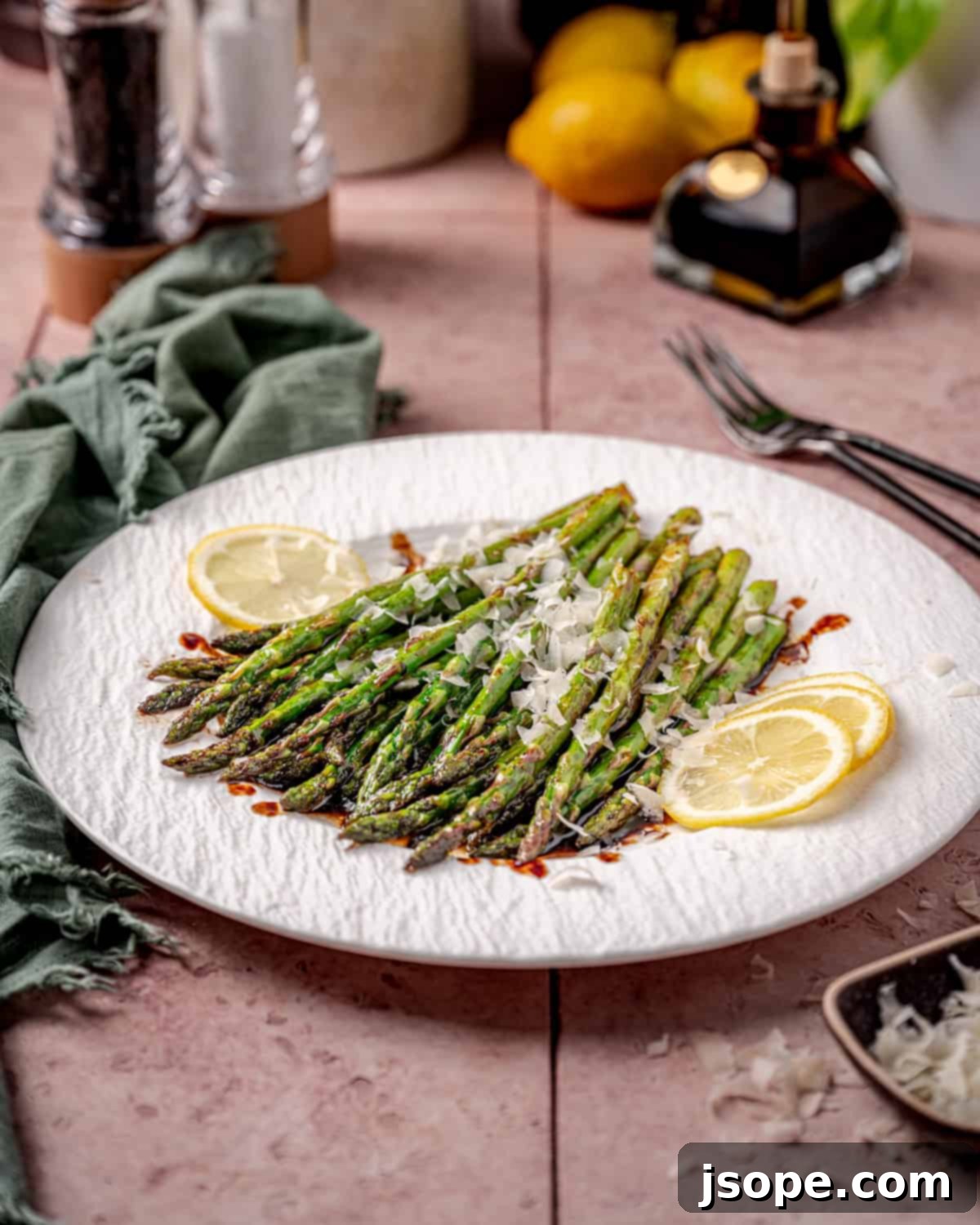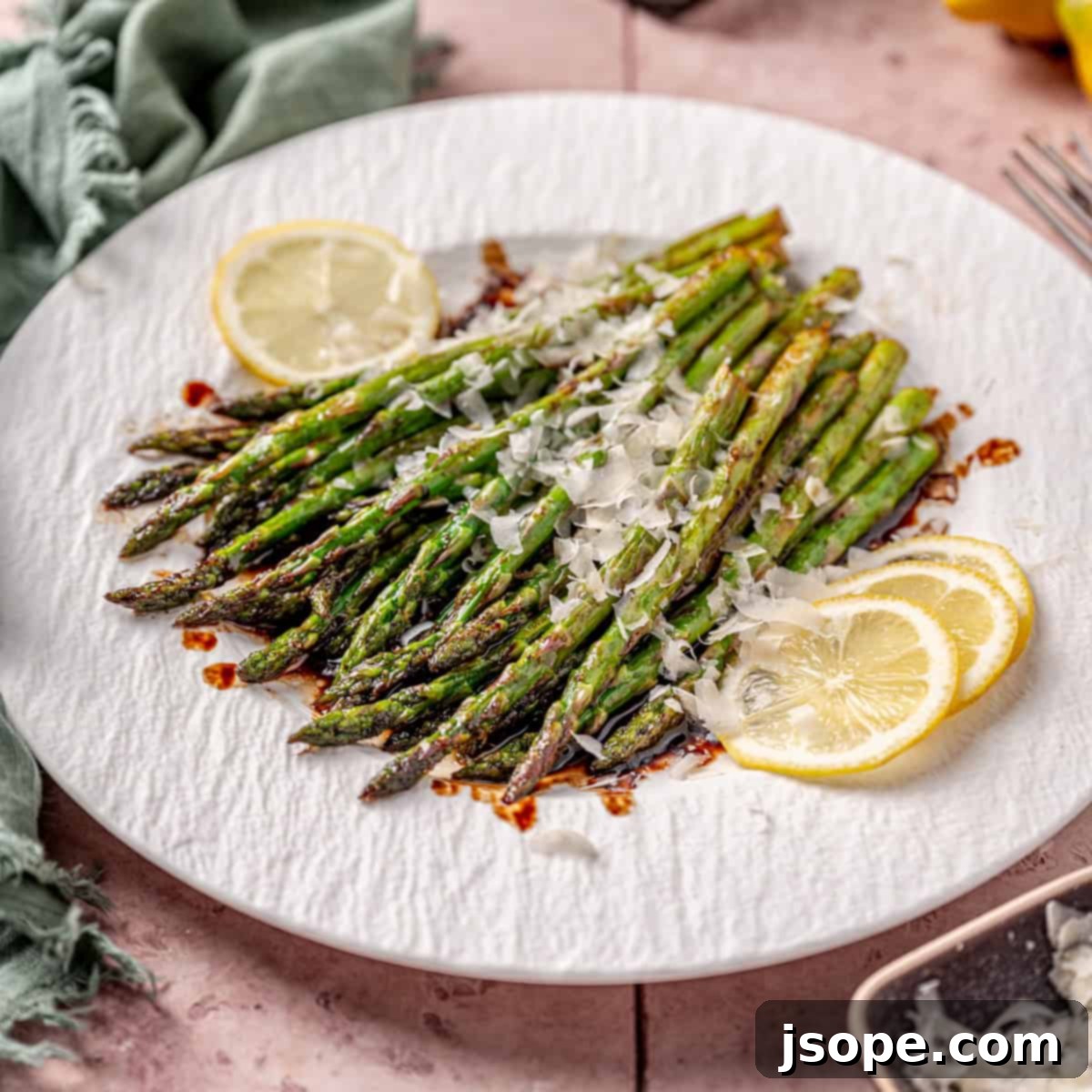As the vibrant colors of spring emerge, so does one of our most anticipated and beloved vegetables: fresh asparagus. Its tender spears and earthy flavor make it a true culinary delight, and we’ve discovered a remarkable way to elevate it further. This easy Sautéed Balsamic Asparagus with Parmesan recipe transforms simple asparagus into an extraordinary side dish, perfect for any meal, from a quick weeknight dinner to an elegant special occasion. The secret lies in a harmonious blend of sweet and tangy notes from high-quality Italian balsamic vinegar, complemented by the savory depth of Parmesan cheese. Prepare to impress your taste buds with this effortlessly delicious and incredibly versatile dish.

For those who appreciate the rich flavor of balsamic vinegar, we have more healthy recipes to explore. Discover our Bruschetta with Marinated Tomatoes and Balsamic Vinegar, a fresh appetizer, or whip up a quick and flavorful Fresh Basil Balsamic Vinaigrette (5-minute Salad Dressing).
Seeking more inspiration for asparagus? Here are some of our personal favorites:
- Spaghetti Carbonara with Asparagus
- Asparagus and Mushroom Cheese Soufflé Bites
- Vegetable Lasagna with White Sauce (featuring asparagus!)
- Goat Cheese Pesto and Asparagus Pizza
Why You’ll Adore This Sautéed Balsamic Asparagus Recipe
This Sautéed Balsamic Asparagus with Parmesan isn’t just another side dish; it’s a culinary revelation that will quickly become a staple in your kitchen. Here’s why we, and soon you, will absolutely love it:
- Effortlessly Quick: From prep to plate, this recipe comes together in minutes, making it ideal for busy weeknights when you crave something gourmet without the fuss.
- Minimal Ingredients, Maximum Flavor: You only need a handful of readily available ingredients to create a dish bursting with complex flavors. Quality over quantity truly shines here.
- Unforgettable Taste: The unique sweet-tangy profile of authentic balsamic vinegar combined with tender-crisp asparagus and savory Parmesan creates an incredibly delicious and addictive taste sensation.
- Perfectly Versatile: Whether you’re hosting a sophisticated dinner party or simply seeking a healthy accompaniment to your family meal, this asparagus side dish fits every occasion seamlessly.
- Healthy & Nutritious: Asparagus is packed with vitamins and antioxidants, making this not only a tasty but also a highly beneficial addition to your diet.
The Allure of Asparagus: A Spring Delicacy
Asparagus is more than just a seasonal vegetable; it’s a nutritional powerhouse and a culinary chameleon. As one of the first vegetables to emerge in spring, it signals the arrival of warmer days and fresh flavors. Rich in vitamins K, A, C, and folate, asparagus also provides essential fiber and antioxidants, contributing to overall health and well-being. Its mild, slightly earthy, and subtly sweet flavor makes it incredibly versatile, pairing beautifully with a wide range of ingredients and cooking methods.
When selecting asparagus, look for firm, bright green spears with tightly closed tips. Avoid any that appear limp, wrinkled, or discolored. For this sautéed recipe, we recommend spears that are roughly the thickness of a pencil or slightly larger, as they cook evenly and retain a desirable tender-crisp texture. Freshness is key to achieving the best flavor and preventing a woody texture, so try to use it within a few days of purchase.
Unveiling the Magic of True Balsamic Vinegar (aka Black Gold of Modena)
Balsamic vinegar is often hailed as the “black gold of Modena” for a very good reason. Genuine balsamic vinegar is a testament to time, tradition, and meticulous craftsmanship, a stark contrast to many mass-produced imitators. To truly appreciate this recipe, understanding the essence of real balsamic vinegar is paramount.
Authentic Traditional Balsamic Vinegar, or Aceto Balsamico Tradizionale, carries the esteemed DOP (Protected Designation of Origin) label. This certification guarantees that the product adheres to the strictest quality standards and originates from a very specific region in Italy: Modena or neighboring Reggio Emilia. These cities, nestled in the Emilia-Romagna region between Tuscany and Lombardy, are the birthplace of this liquid treasure.
The creation of DOP balsamic vinegar is an art form. It begins with local grape must, typically from Lambrusco and Trebbiano varieties. This grape must is slowly cooked until it reduces to a concentrated syrup. This syrup then embarks on a remarkable aging journey, transferred annually to a series of progressively smaller wooden barrels made from different types of wood like oak, cherry, juniper, and chestnut. Each wood imparts unique flavors and aromas as the liquid slowly evaporates and concentrates over time.
The aging process is lengthy, with a minimum of 12 years required for the “Traditional” classification. You might find “Extravecchio” (extra-old) versions aged for 25 years or even more, with some rare bottles boasting 40, 50, or even 100 years of maturation! This extended aging yields a thick, syrupy vinegar with an unparalleled depth of flavor. It’s characterized by a complex umami sweetness, with notes of dried fruit, spices, and wood, and a balanced acidity that is smooth and never harsh.
This distinct flavor profile is why authentic balsamic vinegar is such a cherished ingredient in Italian cuisine. It’s not just a condiment; it’s a flavor enhancer that can transform a simple dish. When selecting balsamic for this recipe, always look for the DOP label to ensure you’re getting the real deal. If a vinegar doesn’t have this label, it’s likely a commercial balsamic, which, while still potentially tasty, often contains added caramel coloring, thickeners, and sugar, and lacks the nuanced complexity of traditional balsamic. Investing in a true DOP balsamic vinegar will undeniably elevate your Sautéed Balsamic Asparagus to a sublime experience.

Essential Ingredients for Perfection
This super easy Sautéed Asparagus recipe truly shines with just a few carefully selected ingredients, all easily found at your local grocery store:
- Unsalted Butter: A small amount of unsalted butter is perfect for sautéing the asparagus, providing a rich base and contributing to a light, flavorful sauce.
- Fresh Asparagus: Opt for fresh asparagus spears that are about the thickness of a pencil or slightly larger. These tend to offer the best balance of tenderness and texture. Look for bright green spears with firm stems and tightly closed tips.
- Dry White Wine: A splash of dry white wine (such as Pinot Grigio or Sauvignon Blanc) adds a delightful body to the sauce and helps to balance the buttery richness, lending a subtle layer of sophistication.
- Kosher Salt & Freshly Ground Black Pepper: Essential seasonings to enhance all the natural flavors. Adjust to your personal preference.
- High-Quality Balsamic Vinegar: This is truly the magic ingredient. While you don’t need the most expensive “extravecchio” (extra-old) variety for cooking, we strongly recommend a 12-year old traditional balsamic with the DOP (Protected Designation of Origin) label. This ensures you’re getting authentic, naturally aged balsamic from Italy, which offers a depth of sweet-tangy flavor that imitations simply cannot replicate.
- Fresh Lemon Juice: Just a touch of fresh lemon juice brightens the entire dish, cutting through the richness and adding a lovely zing that complements the balsamic beautifully.
- Parmesan Cheese: Added at the end, freshly grated Parmigiano Reggiano is crucial for the best flavor. Its salty, nutty notes add another layer of savory deliciousness. Avoid pre-grated varieties, which often contain anti-caking agents and lack the true character of real Parmesan.
Refer to the complete recipe card below for exact quantities.
Smart Substitutions for Every Cook
While this recipe is perfect as written, here are a few common substitutions if you need to adjust based on dietary preferences or available ingredients:
- For Lemon: Any other fresh citrus juice can work wonders! Try a squeeze of lime, grapefruit, or even orange juice for a slightly different aromatic twist.
- For Asparagus: While asparagus is undeniably fantastic here, this technique and balsamic sauce work beautifully with other vegetables. Consider green beans, broccolini, shelled edamame (mukimame), or thinly sliced zucchini for equally delicious results.
- For Parmesan Cheese: Pecorino Romano, a hard sheep’s milk cheese from Italy, offers a sharper, saltier flavor profile if you want to experiment. For a vegan option, nutritional yeast or a good quality vegan Parmesan alternative can be used.
- For Butter: If you prefer a dairy-free option or a different flavor, extra virgin olive oil is an excellent substitute for butter, especially when using a high-quality oil.
Mastering Sautéed Balsamic Asparagus: Step-by-Step Guide
This healthy and flavorful side dish is remarkably simple to prepare, making it accessible for cooks of all skill levels. With just a few straightforward steps, you’ll have this delicious asparagus ready in no time!

Essential Equipment
You truly only need one main piece of equipment for this recipe:
- A large sauté pan or skillet, preferably non-stick or cast iron, to ensure even cooking and prevent sticking.
Step-by-Step Instructions
Step 1: Prepare Your Asparagus and Other Ingredients
- Begin by thoroughly cleaning your fresh asparagus under cold running water to remove any residual dirt or grit.
- To trim the woody ends, gently snap the thicker end of one asparagus stalk; it will naturally break where the tough part meets the tender part. Use this as a guide: line it up with the rest of the bunch and use a sharp chef’s knife to cut all the remaining asparagus stalks at that same breakpoint.
- Measure out your remaining ingredients (white wine, balsamic vinegar, lemon juice, salt, pepper, and Parmesan) into small bowls or ramekins. This ‘mise en place’ ensures a smooth and quick cooking process.
Step 2: Sauté the Asparagus to Perfection
- Place a large sauté pan over medium-high heat. Add the unsalted butter and allow it to melt and begin bubbling.
- Once the butter is fragrant, add the prepared asparagus spears to the pan in a single layer. Cook the asparagus for approximately 90 seconds, turning them a couple of times to ensure even cooking and a beautiful sear. At this stage, they won’t be fully cooked but will have a vibrant color and a slight crispness.
Step 3: Develop the Balsamic Glaze and Serve
- Pour the dry white wine into the pan with the asparagus. Continue to cook, stirring occasionally, until the alcohol aroma has dissipated, which typically takes about 1-2 minutes.
- Stir in the kosher salt, black pepper, high-quality balsamic vinegar, and fresh lemon juice. Continue stirring for about one minute, allowing the sauce to slightly reduce and coat the asparagus evenly.
- Remove the pan from the heat. Add half of the grated Parmesan cheese and stir gently until it melts slightly into the sauce.
- Transfer the Sautéed Balsamic Asparagus to a serving dish and sprinkle the remaining Parmesan cheese over the top for a final flourish.
- Taste one spear to check for seasoning; you likely won’t need more salt, but feel free to add a pinch if desired. For extra indulgence, serve with a small bowl of additional grated Parmesan on the side.
Creative Variations to Explore
Once you’ve mastered the basic recipe, feel free to get creative with these delicious variations:
- Balsamic Sauce Beyond Asparagus: This versatile balsamic reduction can be enjoyed on its own! Omit the asparagus and use the resulting liquid as a savory sauce for grilled chicken, roasted pork, seared steak, or even drizzled over other roasted or steamed vegetables.
- Make it Vegan: Easily adapt this recipe by substituting olive oil for butter and either omitting the Parmesan cheese or using a high-quality vegan Parmesan alternative or nutritional yeast. Extra virgin olive oil will add its own wonderful flavor.
- Add a Nutty Crunch: Elevate the texture and flavor by sprinkling a handful of toasted pine nuts, slivered almonds, or chopped pecans over the finished dish. Toast them lightly in a dry pan before adding for maximum aroma.
- Browned Butter Bliss: For an extra layer of nutty depth, cook the butter a bit longer at the start until it turns golden brown and smells fragrant, creating a delicious browned butter sauce base.
- Brighten with Cherry Tomatoes: Add halved cherry tomatoes to the pan during the last few minutes of cooking with the asparagus. They will soften slightly, burst with sweetness, and add a beautiful pop of color.
- Aromatic Herbs: Fresh herbs like thyme, rosemary, or parsley, finely chopped and added with the balsamic vinegar, can introduce another layer of fragrant complexity.
Storage and Reheating Tips
To ensure your delicious Sautéed Balsamic Asparagus remains enjoyable, follow these simple storage and reheating guidelines:
How to store leftover balsamic glazed asparagus:
- Allow any leftover asparagus to cool completely to room temperature before storing.
- Transfer the cooled asparagus to an airtight container.
- Store in the refrigerator for up to 3 days.
How to reheat leftover asparagus:
- The best way to reheat is in a skillet over low to medium-low heat. Add a tiny splash of water or broth if the sauce seems too dry.
- Gently warm the asparagus, stirring occasionally, until it’s heated through. Avoid high heat, as it can cause the asparagus to become mushy.
- Alternatively, you can briefly warm it in the microwave in short bursts, but a skillet will yield a better texture.
Can you freeze leftover cooked asparagus?
- Yes, you can freeze cooked asparagus, though its texture might be slightly softer upon thawing.
- Ensure it’s completely cooled. Place it in an airtight, freezer-safe container or a zip-top bag, removing as much air as possible to prevent freezer burn.
- Frozen asparagus will keep well for 2-3 months in the freezer.
- To reheat from frozen, simply defrost it overnight in the refrigerator, then warm it gently in a sauté pan over low heat until thoroughly heated.
Expert Asparagus Trimming Tip
A common question is how to properly trim asparagus. Asparagus spears have a natural breaking point where the tough, woody end transitions to the tender, edible stalk. To find this point, simply hold one asparagus stalk firmly at both ends and gently bend it. It will snap naturally, usually between 1 and 3 inches from the bottom. The snapped-off piece is the fibrous, undesirable woody end. To speed up the process for an entire bunch, snap one spear to determine its natural breakpoint, then line up the remaining asparagus stalks and use a chef’s knife to slice them all at that determined point. Done! For very thick asparagus, you might also consider using a vegetable peeler to peel the outer layer of the lower stalk, as it can sometimes be quite fibrous even after snapping.
Troubleshooting Common Cooking Queries
This recipe is quite forgiving, but a few tips can ensure perfection every time:
- Overcooked Asparagus: The most common issue is overcooking, which results in mushy, unappealing asparagus. To avoid this, pay close attention to the cooking times suggested in the recipe. We aim for tender-crisp asparagus with a slight bite or “al dente” texture. Cooking for just 90 seconds initially and then a minute or two with the sauce should yield perfect results.
- Limp Asparagus: If your asparagus seems limp before cooking, give it a quick refresh by trimming the ends and placing them upright in a glass of water in the refrigerator for an hour or two.
- Lack of Flavor: Ensure you are using high-quality ingredients, especially the DOP balsamic vinegar and freshly grated Parmesan. These make a significant difference. Don’t be shy with salt and pepper, and always taste and adjust seasoning before serving.
Perfect Pairings: What to Serve with Balsamic Asparagus
This Sautéed Balsamic Asparagus makes a versatile and elegant side dish that complements an array of main courses. Its vibrant flavor and beautiful presentation make it suitable for both casual family meals and festive holiday spreads. Asparagus pairs exceptionally well with various proteins, offering endless possibilities for your menu:
- Meats: It’s a classic accompaniment to roasted ham, grilled pork tenderloin, pan-seared chicken breast, or even a hearty beef steak. For special occasions, we adore serving it alongside a succulent prime rib roast or a tender Garlic Thyme Studded Beef Tenderloin.
- Fish & Seafood: The bright, tangy notes of the balsamic beautifully cut through the richness of fish. Try it with our Crispy Parmesan Crusted Baked Cod or any flaky white fish.
- Poultry: It’s fantastic with chicken. Our Crunchy Chicken with White Wine Lemon Butter Sauce is a superb match.
- Eggs: Don’t overlook it for brunch! Sautéed asparagus is wonderful alongside poached eggs, omelets, or a classic quiche.

Wine Pairings for a Harmonious Meal
Pairing wine with asparagus can sometimes be a bit challenging due to compounds in asparagus that can make some red wines taste metallic or bitter. However, with the addition of balsamic and Parmesan, the pairing becomes much more enjoyable, especially with the right white wines:
- Dry Riesling: A dry French or German Riesling is an excellent choice. Its crisp acidity and subtle fruit notes beautifully complement the asparagus and balsamic, without clashing.
- Sauvignon Blanc: Especially New Zealand varieties, with their vibrant acidity and herbaceous notes, can create a fantastic synergy with asparagus. The bright flavors enhance the freshness of the dish.
- Unoaked Chardonnay: If you enjoy Chardonnay, opt for an unoaked version. Its clean, crisp profile won’t overpower the delicate flavors of the asparagus, unlike heavily oaked varieties.
- Rosé Wines: Many dry rosé wines, with their refreshing character and subtle red fruit notes, also pair surprisingly well with asparagus. Look for a dry Provence-style rosé.
- Red Wines: Generally, most red wines are tricky with asparagus. If you must go red, choose one with very low tannins and a fruit-forward profile, such as a light-bodied Beaujolais (made from Gamay grapes). Avoid big, tannic reds.
Ultimately, when selecting a wine, it’s often best to consider the main protein or dish you are serving alongside the asparagus. If your main course is a robust red meat, pairing the entire meal with a bold red wine would be perfectly acceptable, as the dominant flavors will guide the pairing.
Frequently Asked Questions (FAQ)
The ideal texture of cooked asparagus is largely a matter of personal preference. We generally prefer asparagus with a tender-crisp bite (al dente), meaning it’s cooked through but still has a slight snap. Some people enjoy it softer, while others prefer it very crunchy. Be careful not to overcook, as significantly overcooked asparagus can become unpleasantly soft and mushy. Following the timing in our recipe below should give you that perfect tender-crisp texture.
Yes, absolutely! You should always trim off the woody, fibrous ends of asparagus. These parts are generally bitter, tough, and texturally unappealing. Our “Expert Asparagus Trimming Tip” above provides an easy method to find the natural breaking point. For very thick spears, it’s also a good idea to peel the outer layer of the lower stalks with a vegetable peeler, as this part can be extra fibrous.
There isn’t a single “best” method, as asparagus is incredibly versatile and shines with various cooking techniques. Boiling, steaming, roasting, grilling, and sautéing (as in this recipe) are all excellent options, each bringing out different qualities of the vegetable. The best method depends on the desired texture and how you plan to serve it. For a quick and flavorful side, sautéing is hard to beat!
For a typical side dish serving, 5-6 medium-sized asparagus spears are generally considered an appropriate portion. This quantity provides a good balance of flavor and nutrition without being overly filling.
Asparagus is a nutritional powerhouse! It’s low in calories and packed with essential vitamins and minerals, including Vitamin K (important for bone health and blood clotting), Vitamin A (for vision and immune function), Vitamin C (an antioxidant), and Folate (crucial for cell growth). It’s also a good source of dietary fiber, which aids digestion, and contains powerful antioxidants that help protect the body’s cells from damage.
More Delicious Side Dishes
Looking for other delectable side dishes to round out your meals? Try these:
- Jalapeño Spinach Artichoke Dip Recipe
- Summer Farro Salad with Zucchini Asparagus and Feta
- White Wine Garlic Butter Sautéed Oyster Mushrooms
- Italian Herb Sautéed Zucchini Squash Recipe
Main Dishes to Complement This Recipe
These are some of our favorite main dishes that pair wonderfully with our Sautéed Balsamic Asparagus:
- Cheesy Pistachio Pesto Chicken with Roasted Cherry Tomatoes
- Braised Veal Shanks with Gremolata (Ossobuco Recipe)
- Chicken with Mushroom Marsala Sauce (Pollo al Marsala)
- Bone-In Veal Milanese Recipe (Cotoletta alla Milanese)
📖 The Full Recipe: Easy Sautéed Balsamic Asparagus with Parmesan

Easy Sautéed Balsamic Asparagus with Parmesan
This quick, easy, and incredibly delicious sautéed balsamic asparagus with Parmesan recipe is the perfect side dish to serve any night of the week, adding elegance and flavor to your table!
Prep Time: 10 mins
Cook Time: 10 mins
Total Time: 20 mins
Course: Side Dishes
Cuisine: Italian
Servings: 4
Calories: 133 kcal
Equipment
- 1 Large sauté pan
Ingredients
- 3 Tablespoons Unsalted Butter
- 1 Bunch of Fresh Asparagus
- ¼ cup Dry White Wine
- Pinch Kosher Salt and Black Pepper
- 2 teaspoons Balsamic Vinegar (DOP recommended)
- ½ teaspoon Lemon Juice
- 4 Tablespoons Grated Parmesan Cheese, divided
Instructions
- Clean your asparagus thoroughly with water. To trim, snap one asparagus stalk to find its natural breakpoint, then line it up with the rest of the bunch and cut all remaining asparagus at that point with a chef’s knife. Measure out your other ingredients for easy addition during cooking.
- Heat a large sauté pan over medium to medium-high heat. Add the unsalted butter and allow it to melt and bubble. Once bubbling, add the asparagus in a single layer and cook for 90 seconds, turning a couple of times to ensure even searing.
- Pour in the dry white wine and cook for 1-2 minutes until the alcohol smell dissipates. Add the salt, pepper, balsamic vinegar, and lemon juice, stirring often for about one minute to create the glaze. Remove the pan from the heat and stir in half of the grated Parmesan cheese. Transfer to a serving dish and sprinkle with the remaining Parmesan. Serve immediately.
Nutrition Information (per serving)
- Calories: 133 kcal
- Carbohydrates: 6 g
- Protein: 4 g
- Fat: 10 g
- Saturated Fat: 6 g
- Polyunsaturated Fat: 0.4 g
- Monounsaturated Fat: 3 g
- Trans Fat: 0.3 g
- Cholesterol: 27 mg
- Sodium: 92 mg
- Potassium: 253 mg
- Fiber: 2 g
- Sugar: 3 g
- Vitamin A: 1156 IU
- Vitamin C: 7 mg
- Calcium: 76 mg
- Iron: 2 mg
Keyword: asparagus, balsamic vinegar, parmesan, sautéed asparagus, spring vegetables, healthy side dish
Food Safety Guidelines
Ensuring food safety is paramount when preparing any meal. Please keep these important guidelines in mind:
- Always avoid leaving perishable food sitting out at room temperature for extended periods, as this encourages bacterial growth.
- Never leave cooking food unattended, especially when using high heat or open flames.
- When sautéing or cooking with oils, choose those with a high smoke point to prevent the formation of harmful compounds and off-flavors.
- Ensure you have good ventilation when using a gas stove to maintain indoor air quality.
For more comprehensive information on safe food handling and preparation, please refer to the guidelines at USDA.gov.
